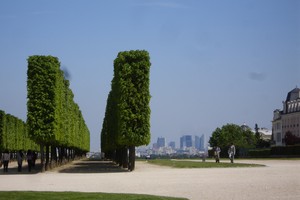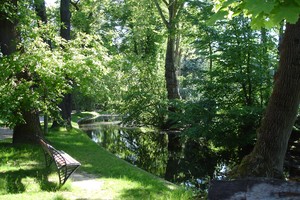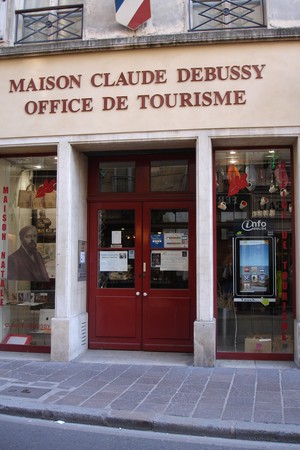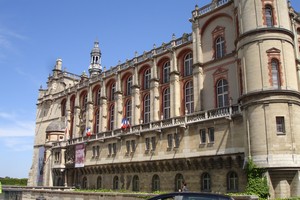A Daytrip to Le Vésinet-Centre and Saint-Germain-en-Laye


- SUBSCRIBE
- ALREADY SUBSCRIBED?
BECOME A BONJOUR PARIS MEMBER
Gain full access to our collection of over 5,000 articles and bring the City of Light into your life. Just 60 USD per year.
Find out why you should become a member here.
Sign in
Fill in your credentials below.
 If you’re starting to think being a tourist in Paris is real work and you need a change of pace, a pleasant and relaxing respite might be a daytrip to two venues outside of Paris – Le Vésinet-Centre, a town of 16,000 located on a loop of the Seine River 16.4 kilometers (10.2 miles) and twenty minutes west of Paris, and Saint-Germaine-en-Laye, a city of 41,000 just 4 kilometers (about 2.5 miles) and just a few minutes further on the same RER line. Go on a sunny day if you can for maximum enjoyment, or at least not on a rainy day.
If you’re starting to think being a tourist in Paris is real work and you need a change of pace, a pleasant and relaxing respite might be a daytrip to two venues outside of Paris – Le Vésinet-Centre, a town of 16,000 located on a loop of the Seine River 16.4 kilometers (10.2 miles) and twenty minutes west of Paris, and Saint-Germaine-en-Laye, a city of 41,000 just 4 kilometers (about 2.5 miles) and just a few minutes further on the same RER line. Go on a sunny day if you can for maximum enjoyment, or at least not on a rainy day.
Logistics: Both venues are on RER Line A1, and Saint-Germaine-en-Laye is the terminus. It would be most efficient to buy all your RER tickets at the same time. You will need one ticket from Paris to Le Vésinet-Centre (4 euros), one ticket from Le Vésinet-Centre to Saint-Germaine-en-Laye (1.75 euros), and one ticket from Saint-Germaine-en-Laye back to Paris (4 euros). Be sure to keep your ticket for every stop because you will need it to exit the station. Le Vésinet-Centre is the ninth stop if you leave from Chatelet, in central Paris.
To find the RER Line A1 train that will stop in Le Vesinet-Centre, look for the track that will go in the direction of Saint-Germain-en-Laye. Look at the overhead panel and see what destinations are lighted. The next train arriving will make those stops. If the lights for Le Vésinet-Centre and Saint-Germaine-en-Laye are lighted, take that train. If they are not lighted, wait until they are.
Le Vésinet-Centre: Note that there are two Le Vésinet stops – Le Vésinet-Centre and Le Vésinet-Le Pecq. Le Vésinet-Centre comes first and that is the one you want. The train arrives on the residential side of the tracks. If you want an immediate dose of peace, take the sortie (exit) that says av. Maurice Bertaux and start your leisurely walk there.
But first, a gentle note. Please be aware that this is not a tourist area; it is a very quiet neighborhood. So please be on your best manners. That means no noise, no trash, and no loud voices. You might have already noticed that French people speak just loudly enough for the person they are addressing to hear them. Your considerateness will be most appreciated.
Once you exit the station, cross the street and walk toward the greenspace. Take a moment to listen to the quiet. Head down the walk on the right side of the greenspace, then pick up the path that goes diagonally left, where you will begin making a loop through the neighborhood. When you come to a fork, bear right. You will be walking along a path next to a canal. The canals, which are named after Sister Cities, were part of the design of the town, and many residents have a canal running through the back of their property.
 Keep an eye out for a low wooden sign on your left that says “Promenade d’Unterhaching.” You will have to turn around to see what the sign says. Be sure to look back at the view for as idyllic a scene as you are ever to see. Looking back, there will be a bench on the left of the canal, and there might be ducks and swans if you’re lucky. The light and shadow playing on the water on a sunny day, coupled with the serenity, are exquisite. Take advantage of the calm and beauty and sit on the bench and just enjoy the moment.
Keep an eye out for a low wooden sign on your left that says “Promenade d’Unterhaching.” You will have to turn around to see what the sign says. Be sure to look back at the view for as idyllic a scene as you are ever to see. Looking back, there will be a bench on the left of the canal, and there might be ducks and swans if you’re lucky. The light and shadow playing on the water on a sunny day, coupled with the serenity, are exquisite. Take advantage of the calm and beauty and sit on the bench and just enjoy the moment.
 When ready, proceed in the direction you were heading until you come to Allée d’Isly and take a right to head back toward the train station and the center of town. You will walk by Avenue Georges Clemenceau and Allée Garibaldi on the left. You can explore these streets to see the variety of domestic architecture, which ranges from the modest to the stately. The first houses were built in the village of Vésinet in 1861. Josephine Baker, the famous black American who wowed Parisians at the Folies Bergère in the 1920s, owned a mansion at 52, Avenue Georges Clemenceau, where she lived from 1929 to 1947. The structure, completed in 1891, has ten bedrooms where lived the many Alsatian orphans Baker cared for.
When ready, proceed in the direction you were heading until you come to Allée d’Isly and take a right to head back toward the train station and the center of town. You will walk by Avenue Georges Clemenceau and Allée Garibaldi on the left. You can explore these streets to see the variety of domestic architecture, which ranges from the modest to the stately. The first houses were built in the village of Vésinet in 1861. Josephine Baker, the famous black American who wowed Parisians at the Folies Bergère in the 1920s, owned a mansion at 52, Avenue Georges Clemenceau, where she lived from 1929 to 1947. The structure, completed in 1891, has ten bedrooms where lived the many Alsatian orphans Baker cared for.
If you are up for exploring the town, then when you reach the train station, look to the right of the phone booth for the staircase you descend that leads to an underpass that will bring you to the commercial side of town. When you arrive on the other side, look for the Picard store to the left and head in that direction and turn right on rue du Maréchel Foch. This is one of the central streets in town and on it you will see all the shops that serve every French town, village, and neighborhood – the boulangerie, the coiffure, the boucherie, the charcutier, the pharmacie, the wineshop, and so on.
At the church, turn left and then right and then left onto rue Thiers where, if you go on a Saturday, there is a large market selling everything from brioche to bathing suits. The Hazard Boulangerie on the left sells good house-made confiture, or jam.
When ready, return to the RER station. If you did not buy your ticket before boarding in Paris, you can buy a ticket to Saint-Germain-en-Laye from one of the ticket-dispensing machines. Take the train on the track on the commercial side of town.
Saint-Germain-en-Laye: The ride to Saint-Germain-en-Laye takes less than ten minutes. When you arrive, leave through the Hotel de Ville exit, come up the esclator, and when you reach the top, take a moment to look at the surroundings. To the left, across the street, you will see Les Châteaux de Saint-Germain, which dominates the center of
this city, much of the layout of which dates back to the Middle Ages. There are also a number of cafes that front the busy main street.
 For the moment, however, turn right onto rue de la Salle and take the first left onto rue au Pain to number 38, which houses both the Tourist Office on the ground floor and the Debussy Museum on the first floor. Get a map from the Tourist Office to get the layout of the city, and be sure to get a brochure that explains the history of the chateaux and that tells about other sites (both are available in English). Then take a few minutes to visit the two-room apartment upstairs where Debussy was born in 1862. The building dates to 1680. Be sure to note the well-preserved courtyard staircase and balustrade.
For the moment, however, turn right onto rue de la Salle and take the first left onto rue au Pain to number 38, which houses both the Tourist Office on the ground floor and the Debussy Museum on the first floor. Get a map from the Tourist Office to get the layout of the city, and be sure to get a brochure that explains the history of the chateaux and that tells about other sites (both are available in English). Then take a few minutes to visit the two-room apartment upstairs where Debussy was born in 1862. The building dates to 1680. Be sure to note the well-preserved courtyard staircase and balustrade.
Exit the Tourist Office and from here you can turn left and explore the town, or you can retrace your steps and head toward the chateaux. If you are hungry and would prefer a relatively quiet place to eat on the way, you can stop at La Crepiere at 8, rue de la Salle for a quick bite. There are many other restaurants across from the chateaux and all through the city.
 There has been a structure on the site of the chateaux since the 12th century, and the current structure dates to 1539. Charles IX and Louis XIV were born at Saint Germain, Louis XIII died there, and Mary Queen of Scots lived there from age 6 to 16. The 1919 peace treaty with Austria was signed at the chateaux.
There has been a structure on the site of the chateaux since the 12th century, and the current structure dates to 1539. Charles IX and Louis XIV were born at Saint Germain, Louis XIII died there, and Mary Queen of Scots lived there from age 6 to 16. The 1919 peace treaty with Austria was signed at the chateaux.
The chateaux also houses the Musée d’Archéologie Nationale (the National Archeology Museum), created by Napoleon and opened in 1867 and recently renovated. The museum houses the world’s largest collection of prehistoric art – nearly 30,000 pieces – including the Lady of Brassempouy, which dates from around 21,000 BC and which is thought to be the oldest representation of a human face.
The highlight of a visit to Saint-Germain-en-Laye is a leisurely walk through the gardens to the north of the chateaux, which were laid out by André Le Nôtre, principal landscape architect to Louis XIV, between 1663 and 1673. Le Nôtre also designed the parks at Versailles and Fontainebleau, and he made a significant contribution to the planning of the Tuileries Garden in Paris. At 3,500 hectares (over 8,600 acres), there is plenty to explore, but the end point of your walk should be the belvédère, or view point, on the east side of the garden.
Enter the grounds and begin by walking in a northward direction and wending your way eastward. You will pass gardens and a couple of outdoor kiosks where you can grab a drink and relax in a reclining chair. There is also a memorial to those who died in World War I. Eventually you will come to the easternmost border, which is the 2.4-kilometer (3-mile) view point. Take a right – that is, head south, back toward the chateaux. You will pass the viewpoint indicator, which is a semicircular structure that indicates points of interest beyond the terrace, including Paris, which is 19 kilometers (12 miles) east but still quite visible. Enjoy the panoramic view. Especially on a clear day, it is impressive.
As you head south, note the terrace on the right and a small vineyard on the left. Grapes have been grown on the grounds since the 13th century.
To conclude your visit to the chateaux, you will see le Pavillon Henri IV at the end of the view point on the left, facing south. This is a vestige of a chateau where Louis XIV was born in 1638. It is now an upscale hotel and restaurant, but it preserves a one-room museum on the ground floor dedicated to Louis XIV.
You can return to the RER station by walking alongside the large chateau on the garden side, or you can exit through the parking lot of le Pavillon Henri IV and walk through the upscale neighborhood just beyond.
The trains to Paris run frequently, and the return trip should take under a half hour from Saint-Germain-en-Laye to Chatelet.
Birthplace of Claude Debussy
Tel: 01 30 87 20 63
38, rue au Pain
78100 Saint-Germain-e –Laye, France
Open: Tues–Sat 2pm–6pm
During this 150th anniversary year of Debussy’s birth, the museum is also open Sun
2pm–6pm until Sept 16
Closed from July 31 to Aug 31
From Nov to Feb: 2:30 p.m. to 5:30 p.m.
Closed during bank holidays
Entrance if free
Musée d’Archéologie Nationale et Domaine National de Saint-Germain-en-Laye
Tel: 01 39 10 13 00
Place Chares de Gaulle
78100 Saint-Germain-en-Laye, France
Open: Everyday but Tues 10am – 5:15pm
Closed Tuesdays
From May 1–Sept 30: Sat, Sun, and bank holidays: 10am–6:15 pm
Entrance fee: 6 euros
Reduced fee: 4.50 euros
Subscribe for FREE weekly newsletters.
BonjourParis has been a leading France travel and French lifestyle site since 1995.
Readers’ Favorites: Top 100 Books, imports & more at our Amazon store
We update our daily selections, including the newest available with an Amazon.com pre-release discount of 30% or more. Find them by starting here at the back of the Travel section, then work backwards page by page in sections that interest you.
Current favorites, including bestselling Roger&Gallet unisex fragrance Extra Vieielle Jean-Marie Farina….please click on an image for details.
Click on this banner to link to Amazon.com & your purchases support our site….merci!
More in France, France travel, French tourism, tourism, walking tour






